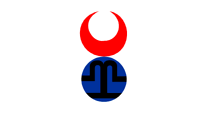Reich der Goldenen Horde |
|
|
|
| Übersicht – Contents: | |
Reich der Goldenen Horde |
|
|
|
| Übersicht – Contents: | |
Flagge – Flag: |
|
 |
Flagge des Reiches der Goldenen Horde |
| Die überlieferte Flagge der Goldenen Horde in der Zeit nach Khan Batu war offenbar weiß mit einem roten Halbmond in der Mitte (seit dem Jahr 1313 ist der Islam Staatsreligion), sowie einem schwarz-blauen Symbol darunter. Blau ist die Nationalfarbe der Mongolen und ihrer turksprachigen Nachfolgenationen. Das in der Flagge der Goldenen Horde gezeigte Symbol ist in sofern interessant, dass es noch heute von den Krimtataren verwendet wird. | The
handed down flag of the Golden Horde in the times after Khan Batu was
obvious white with a red half-moon in the middle (since the year 1313 is the
Islam state religion), as well as a black-blue symbol beneath. Blue is the national color of the Mongolians and their Turk succession nations. The in the flag of the Golden Horde showed symbol is interesting from there that it is till today in use by the Crimean Tatars. |
| Quelle/Source: Volker Preuß | |
|
1196 · der mongolische Fürst Temudschin wird Dschingis Khan 1202–1227 · Ausdehnung des Mongolenreiches durch brutale Raubzüge und Eroberungen, Territorium: heutiges Korea, Mandschurei, Mongolei, Ostturkestan, Tadschikistan, Kirgisien, Turkmenistan, Usbekistan, Afghanistan, Kasachstan und südsibirische Gebiete unterhalb des 60. Breitengrads bis zum Ural-Gebirge 1227 · Tod des Dschingis Khan, Aufteilung des Reiches unter die Erben: Tschutschi → Westsibirien; Ügedei → China, Korea, Mongolei und Mandschurei; Tschagatai → Ostturkestan, Tadschikistan, Kirgisien und Usbekistan; Subutai → Afghanistan und Turkmenistan 1236 · Batu, der Sohn Tschutschis des Stammvaters der Goldenen Horde, bricht aus dem Südural-Gebiet auf und erobert das Reich der Wolga-Bulgaren 1238 · Batu unterwirft die russischen Fürstentümer bis zum Dnepr 1240–1241 · Batu erreicht und bedroht Ungarn und Schlesien 1254 · Batu gründet Sarai, die Hauptstadt des Reiches, an der Mündung der Wolga 1255 · Batu stirbt in Sarai 1256 · Berke wird Khan der Goldenen Horde und tritt zum Islam über 1260 · Berke gründet Neu-Sarai am Wolga-Knie 1313 · Usbek wird Khan der Goldenen Horde, erhebt den Islam zur Staatsreligion, und verlegt die Hauptstadt nach Neu-Sarai 1360–1380 · Erbfolgestreitigkeiten und verlustreiche Auseinandersetzungen mit Litauern und Russen 1395 · Timur zerstört Neu-Sarai 1420 · Zerfall des Reiches der Goldenen Horde in mehrere einzelne Khanate (u.a. Khanat Astrachan, Khanat Sibir, Khanat Krim, Khanat Kasan) 1480 · Ende der mongolischen Oberherrschaft in Russland, Zerstörung der Hauptstadt Sarai 1502 · Vertreibung des letzten Khans aus Russland 1584 · das Khanat Sibir wird als letzter bestehender Nachfolgestaat der Goldenen Horde von Russland erobert |
|
1196 · the Mongolian prince Temudshin becomes Dshingis Khan 1202–1227 · expansion of the Mongolian Empire by brutal incursions and conquest, territory: today's Korea, Manchuria, Mongolia, East Turkestan, Tajikistan, Kyrgyzstan, Turkmenistan, Uzbekistan, Afghanistan, Kazakhstan and south Siberian areas below the 60th degree of latitude to the Ural-Mountains 1227 · death of Dshingis Khan, division of the Empire under four heirs: Jochi → Western Siberia; Ogodei → China, Korea, Mongolia and Manchuria; Chagatai → East Turkestan, Tajikistan, Kyrgyzstan and Uzbekistan; Subutai → Afghanistan and Turkmenistan 1236 · Batu, the son of Jochi the progenitor of the Golden Horde, starts out of the southern Ural area and conquests the Empire of the Volga Bulgarians 1238 · Batu subject the Russian principalities to the Dnepr river 1240–1241 · Batu gains and endangers Hungary and Silesia 1254 · Batu founds Sarai, the capital of the Empire, near the mouth of the Volga river 1255 · Batu dies in Sarai 1256 · Berke becomes Khan of the Golden Horde and converts to the Islam 1260 · Berke founds New Sarai near the Volga Knee 1313 · Usbek becomes Khan of the Golden Horde, levies the Islam to state religion, and relocates the capital to New Sarai 1360–1380 · heritage succession quarrels and inconvenient quarrels with Lithuanians and Russians 1395 · Timur ruins New Sarai 1420 · disintegration of the Empire of the Golden Horde in several particular Khanates (e.g. Khanate of Astrachan, Khanate of Sibir, Khanate of Crimea, Khanate of Kasan) 1480 · end of the Mongolian supremacy in Russia, destruction of the capital Sarai 1502 · expulsion of the last Khan out of Russia 1584 · the Khanate of Sibir gets conquested by Russia as the last existing succession state of the Golden Horde |
| Quelle/Source: Atlas zur Geschichte, Discovery '97 |